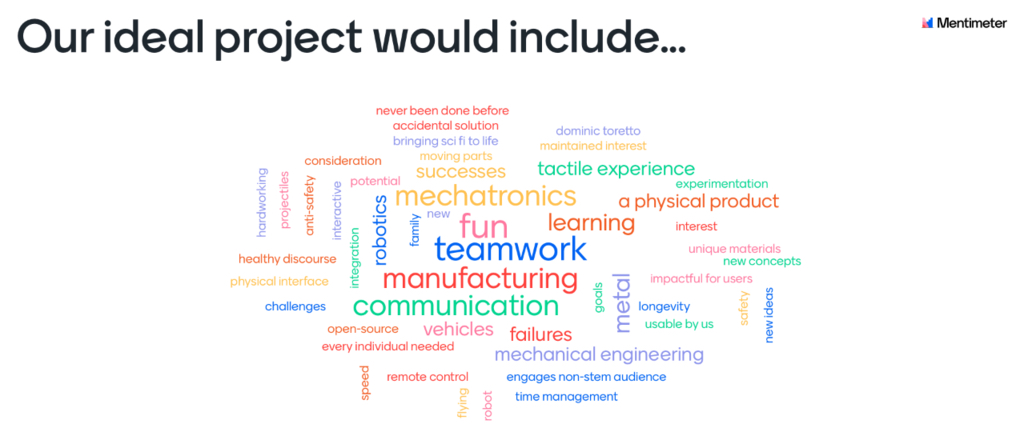See Our Schedule
Project Milestones and Overall Schedule
Project Selection:
The team navigated through an iterative process of surveys, discussions, and proposals to arrive at the main function of the project. While on Day 1, each team member has individual ideas about driving the project forward, an initial step was taken to discover what all team members were interested in, embodied by this word cloud. Thus, word clouds, rankings, and surveys comprised the initial stages of the project. The shared interests and overall project expectations included Mechanical Engineering, Teamwork, Manufacturing, Mechatronics, Fun, and Effective Communication. Similarly, the top priorities were to “Learn New Concepts”, “Have Everyone’s Voices Heard and Appreciated,” and “Be Proud of the Final Product.” In each step, the team had detailed discussions regarding the why behind the project, and to ensure that all members continued to remain excited about the project.

The second step past the initial surveys was splitting into groups to come up with project proposals. There were five initial proposals: a self-constructing robot, a system of a glove providing haptic feedback and control of a robotic arm, an exo-suit, a dragonfly drone, and a disaster relief robot. Each proposal was given some research, an idea of the functions of the project, and how it would tie in to the team’s overall goals and interests. The proposal that was landed on was the disaster relief robot because it felt like the most important to the team and accommodating to the various expressed interests.
The discussion didn’t end once we landed on a project proposal. One of the most divisive topics among the team was the prioritization of impact and use case versus learning opportunities and “cool factor.” Disaster relief as a title was geared more towards the former, so when coming up with the main function of the robot, the team worked to find a middle ground. The main function became to assist the user with reconnaissance, two-way communication, and carrying supplies, while in submerged environments and on rugged earth. This broadening of the impact but focusing on the deliverable product allows both use case and cool factor to shine.
Finally, now that the main function of the robot was developed, the team could christen themselves. The Hybrid Area Robotic Reconnaissance Team, or HARRT for short, describes the function of our product while defining us as a team that works from the heart to make and keep each and every one of us excited about the project.
The amphibious robot that HARRT aims to create will be developed through a combination of a top-down and bottom-up approaches. Initially, the individual members of the team shared concepts for any multi-terrain robot we could possibly imagine. Then, as a group, we came to a consensus on a more well-defined image of our intended solution, drawing on the individual concepts and carefully picking which attributes we most wanted to give the robot. This process of individual concept generation followed by group discussion has been a defining characteristic of our approach. Through repeated bouts of individual idea generation followed by group efforts to combine the best aspects of those ideas, we have arrived at a proposed solution that has its origins in a diverse group of several design concepts. Our ideal outcome for the semester and year includes a robot with all of the functionalities listed on this website, but in an effort to gain traction in our design efforts, we have made it our immediate, explicit goal to produce detailed plans and designs for what we have called our Minimum Viable Product (MVP). This MVP has come to include the land and water movement functionalities, as well as the ability to transition between them. With these decisions made, we began another cycle of individual concept generation, narrowing the scope and constraints on the designs. Through this latest cycle of generation and consolidation, we have arrived at a specific embodiment for the MVP: a four legged robot whose legs terminate in wheels, designed so that treads can be installed when necessary, equipped with two Hamilton jets for locomotion in water. Moving forward HARRT has decided to split into four subgroups including, legs, wheels, buoyancy, and Hamilton jet. This would allow for expansion into the different tracks of design for this robot.
We have begun identifying our constraints and metrics based on anticipated design issues and requirements. Values were established for these constraints and metrics by analyzing existing research and development of robots with similar functions. We have grouped these constraints and metrics chiefly by relevance to one of the main subfunctions (land movement, water movement, and transitioning), with the intent of adding any others that become apparent as we progress and develop an intuition for what parameters are practical and feasible for our design.
